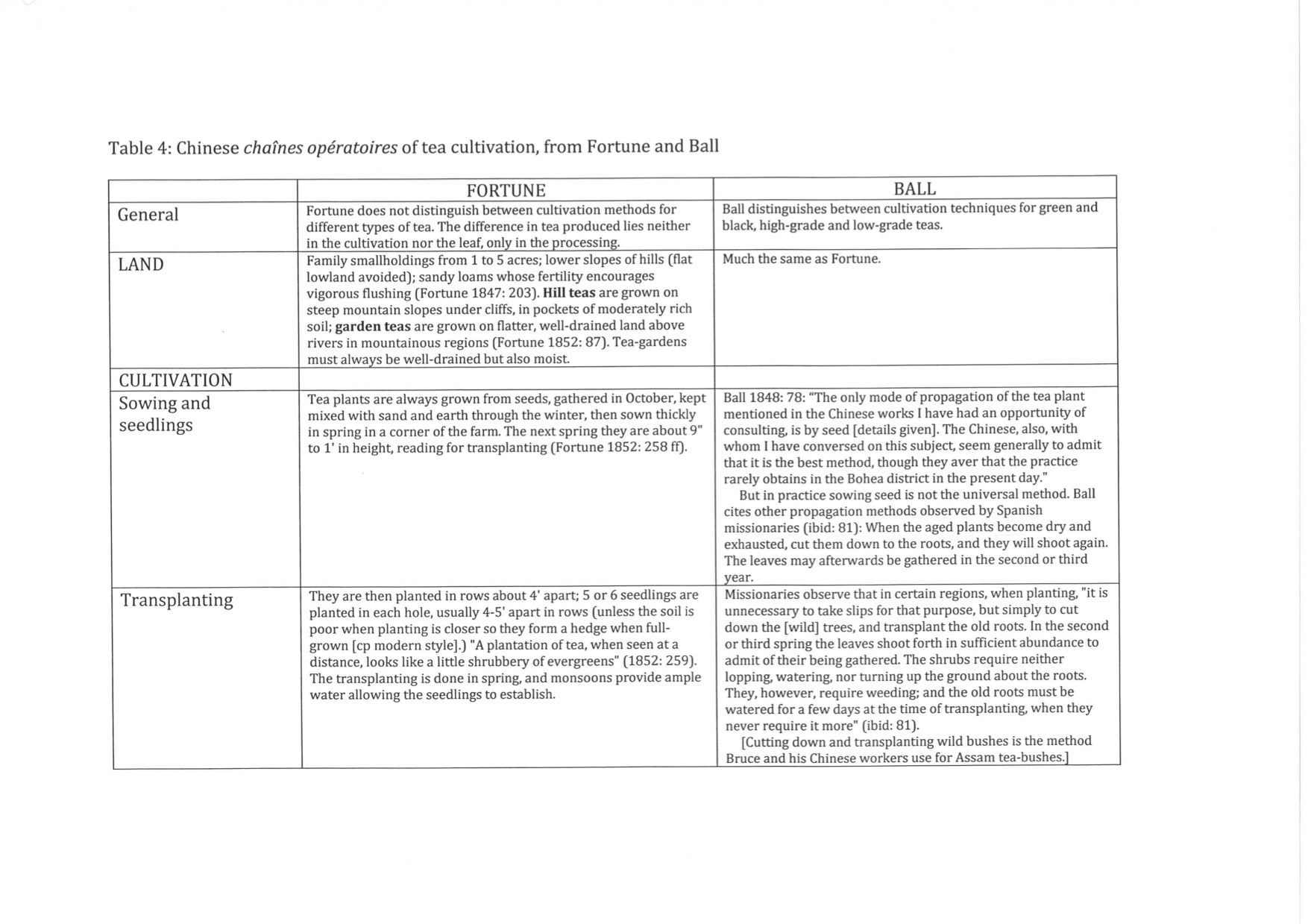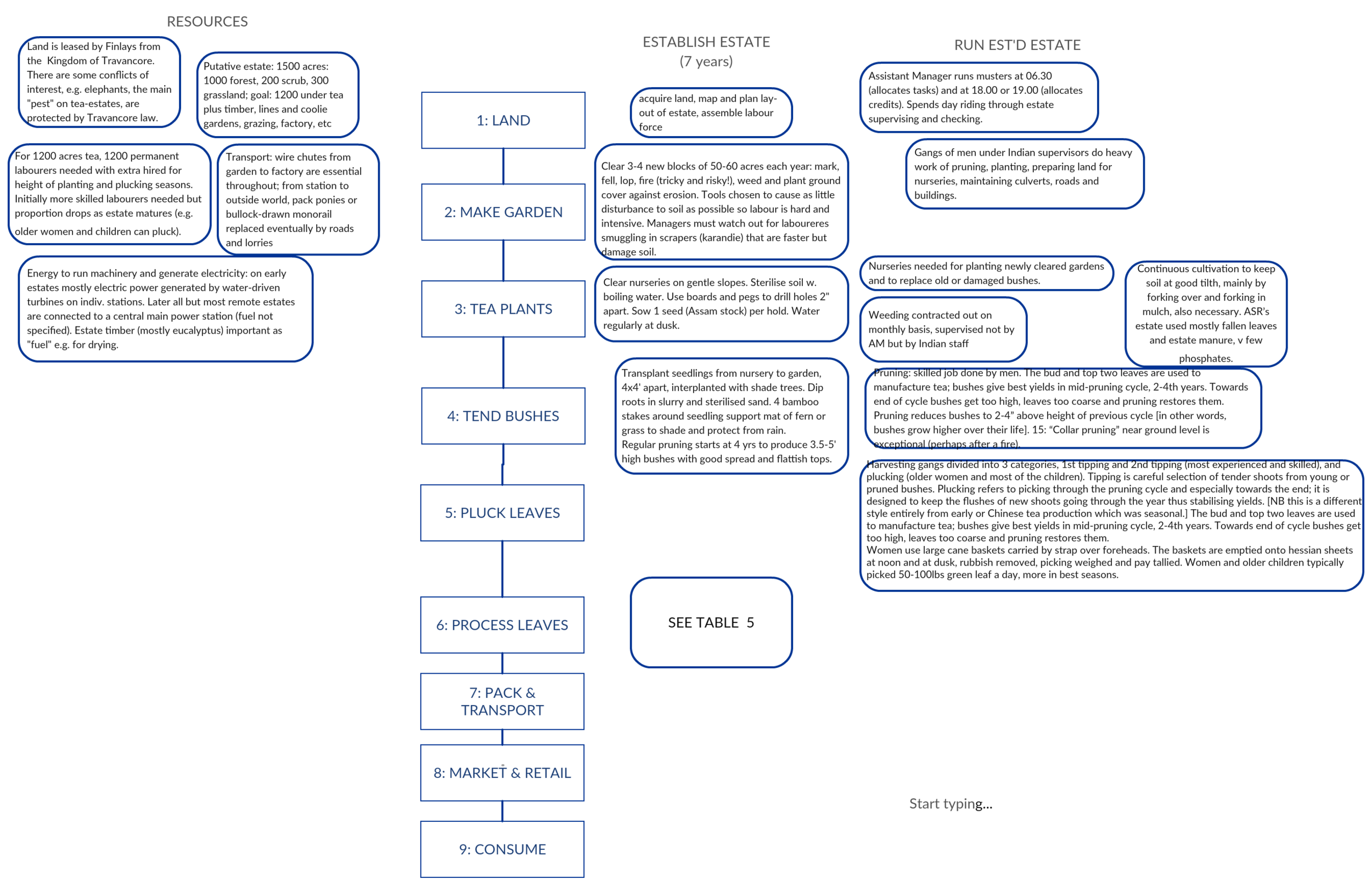Tea
Transplanting the Teascape from China to India
Abstract: In the late 1830s the British began growing tea in Assam to substitute
for expensive imports from China. They initially sought to transplant a complete
system of tea plants, expert workers and tools from China. But by the 1880s
British tea-planters were congratulating themselves on having rid themselves of
the “incubus of the Chinese plant” and the “crude” methods of Chinese tea-
makers. This chapter uses the device of the chaîne opératoire (procedural
sequence) to explore the translation of tea technology and the re-making of “tea
as thing” (plant, commodity and beverage) on Indian soil over the century
between 1839 and the 1930s.
I began work on this project at the Max Planck Institute for the History of Science
in 2014, and this investigation of how a crop-system travels, based on mapping
successive formulations of the tea-production chaîne opératoire, helped inspire
the collaborative Moving Crops project and the formulation of the cropscape as
an object/method of historical investigation.
A tea plant (Camellia sinensis), its flowers and seeds, bordered by six scenes illustrating its use by man. Coloured lithograph, c. 1840. One of a set of six prints showing economic plants and their uses, this illustration was produced at the time that the Assam experiment in tea-growing was just beginning. It shows tea cultivation, processing and packing as a purely Chinese process, geared to a market of British retailers and consumers. A group of genteel English ladies is shown tracing the distant roots of tea-production on a globe perched on their tea-table amidst the delicate China tea-service.
Credit: Wellcome Library no. 28058i
“The chaîne opératoire is a conceptual and visual tool initially developed by French anthropologists of techniques and much favored by archaeologists. It lays out the core sequence of technical processes that go into the production of an artefact or the exercise of a skill, and provides a clear framework for feeding in information about the inputs and outputs, material, intellectual, social or ritual, specified at each stage. It is an organizing device developed specifically for mapping technical assemblages in motion.”
Upcoming Publication
This study of transplanting tea from China to India will be published as Chapter 6 in Entangled Itineraries of Materials, Practices, and Knowing across Eurasia, edited by Pamela H. Smith, Pittsburgh University Press, forthcoming 2019.
The following diagrams and tables represent the complete set of illustrations to the book-chapter. They highlight the chaîne opératoire as a method for comparing sociotechnical systems and their evolution over time and space. I compare four historical moments or phases in the transplantation of Chinese tea-production to Assam and the subsequent development of the Indian tea industry: (1) the original methods as practised in South China’s tea-exporting regions and their adaptation in the 1840s in Assam; (2) the decades of erratic technological and economic progress between 1840 and 1870; (3) trends post-1870, by which time the industry had stabilised and steadily overtook China in the volume of exports to Britain; and (4) the normalised running of a South Indian tea-estate in the 1930s and 1940s, a century after the crop’s introduction on Indian soil.
REFERENCES
Antrobus, H.A. (1957) A History of the Assam Company, 1839-1953. Edinburgh: T. and A. Constable.
Ball, Samuel (1848) An Account of the Cultivation and Manufacture of Tea in China: derived from personal observation with remarks on the experiments now making for the introduction of the culture of the tea tree in other parts of the world. London, Longman & Co.
Bruce, C.A., Superintendent of Tea Culture (1839) Report on the Manufacture of Tea, and on the Extent and Produce of the Tea Plantations in Assam. Transactions of the Agricultural and Horticultural Society of India, vol. VII, repr. as Appendix 3, Antrobus 1957: 463-476. [This paper was presented by the Tea Committee, and read at the Meeting of the Society on Wednesday, 14th August 1839.]
Crole, D. (1897). Tea: A text book of tea planting and manufacture. With some account of the laws affecting labour in tea gardens in Assam and elsewhere. London, Crosby Lockwood & Son.
Fortune, Robert (1847) Three Years’ Wanderings in the Northern Provinces of China, Including a Visit to the Tea, Silk and Cotton Countries. London: John Murray.
- (1852) A Journey to the Tea Countries of China and India. London: John Murray (facs. repr. Cambridge: Cambridge University Press, 2012).
Money, E. (1883). Tea – Cultivation and Manufacture. Fourth edition, revised and supplemented by additional chapters. London, W. B. Whittingham & Co.
Robertson, A.S. 1976/9. Oral history of tea planting in South India. Oral History Archive, Centre for South Asian Studies, Cambridge; typed transcription and illustrations in author’s family collection.
Tea Gazette (1885) Tea Planter's Vade Mecum. Calcutta: Office of the Tea Gazette, 1885 [repr. 1886: London, W.B. Whittingham & Co.]
















